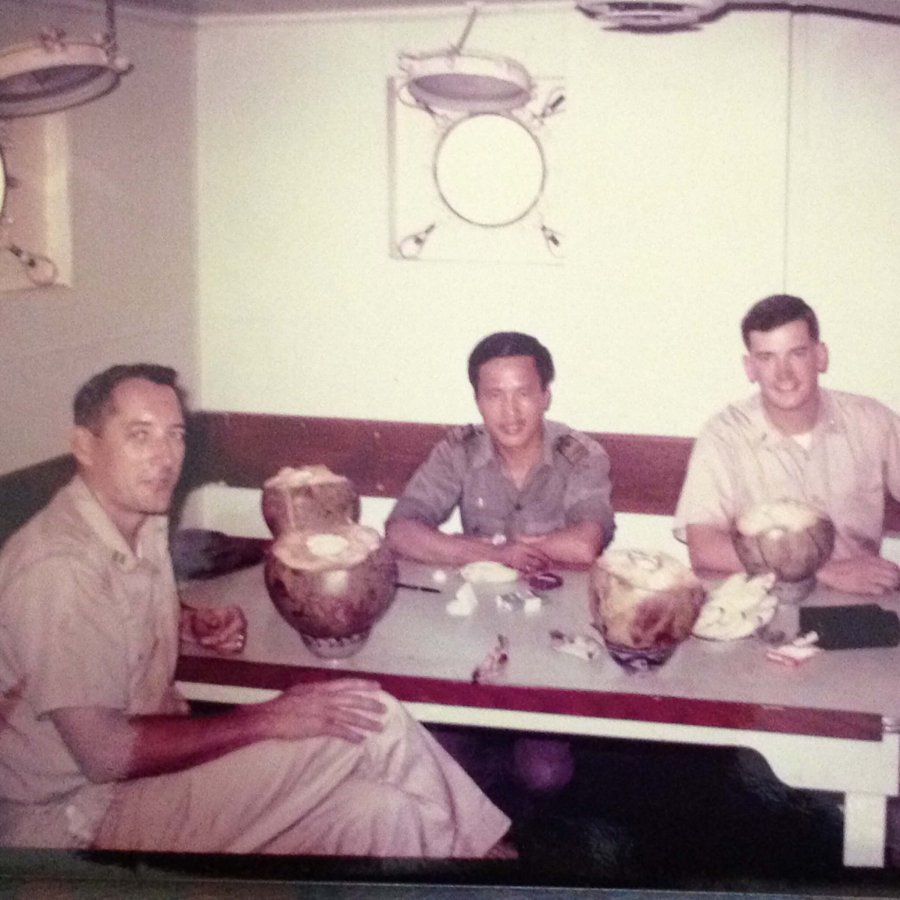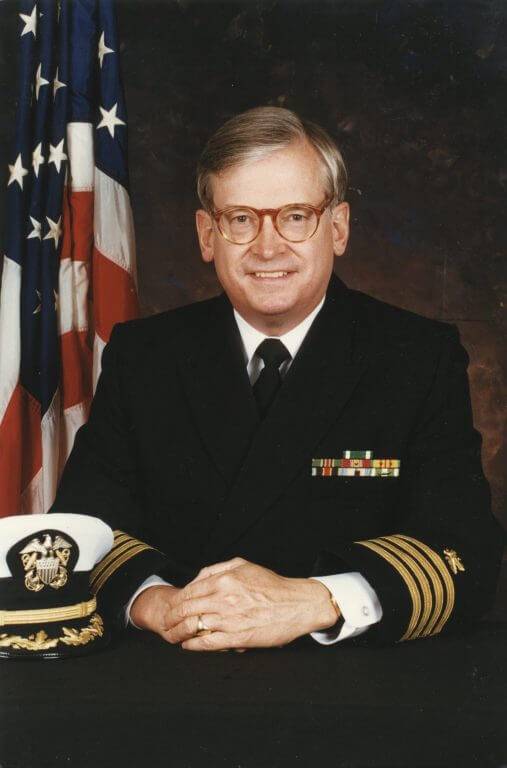
 A Minnesota PBS Initiative
A Minnesota PBS Initiative
I interrupted my two year MBA studies at the U of Minnesota graduate school of business administration to enter the Navy in 1968.
I was accepted into Officer Candidate School, Newport, Rhode Island. After being commissioned an Ensign, I spent the next 6 months at the Navy Supply Corps School, Athens, Georgia.
Upon graduation I was assigned as the Supply Corps Officer for USS CARRONADE (LFR-1), an inshore fire support rocket ship homeported in Yokosuka, Japan.
We deployed most of the time in the coastal waters around the southern part of South Vietnam. We operated as a mobile artillery platform for units engaged south from Cam Ranh Bay to the Mekong Delta and around towards Cambodia.

Taken in October 1969 on board a Vietnam gunboat that we operated with. We were invited by their captain to join them for some coconut. We were near Vung Tau at the time. From left to right: Lt Donald Larison, Executive Officer of USS CARRONADE, the Vietnamese captain of the gunboat, and me LT(jg) Ken Willcox.
The rockets were 5-inch, spin stabilized. There were two types; one with a range of one mile; the other, 5 miles. The ship was about half the size of a destroyer but had the firepower of 5 destroyers. With 8 rapid fire rocket launchers we could put out a devastating rocket barrage with hundreds of rockets obliterating the equivalent of many city blocks.
We also had a 5-inch cannon and twin 40 millimeter cannons when precision was required. We were engaged most days. In the night time if there was not an operation ashore underway, we fired H & I (harassment and interdiction) fire at suspected Viet Cong areas of activity.
Our magazine carried 20,000 rockets. We would fire them off in about 10 days. We would return to Cam Ranh Bay, where we would reload rockets into the ship's magazine. Each rocket weighed about 75 pounds. They were passed hand to hand down to the magazine.
CARRONADE was the only ship of its kind in the Navy. So repair could become a problem. When the rocket launchers needed repair, they had to be lifted out of the ship and air freighted back to the U.S. Most of our repairs were done at the Ship's Repair Facility (SRF) in Subic Bay, Philippines. We would go there every 6 weeks or so for refit and repairs.
The propulsion system was also quirky. It relied on a variable pitch screw vs stopping and reversing the direction of the shaft. But we were never certain that the speed command would translate accurately to the screws. Thus "ahead two-thirds" could find the ship going ahead one-third. Steering would occasionally fail as well. Most of the time in Vietnam we were cruising slowly at about 3 knots along a designated coastal stretch awaiting a call to fire from the Marine spotter planes, or Marines on the ground.
The rockets were allegedly left over from World War II. They were not wholly reliable. Some would launch and splash down in the water. Others were duds that would not exit the launch tubes. The first time I saw one of the gunners mates pounding on the nose of a rocket with a 2 X 4 stuck in the launcher I almost ducked for cover. CARRONADE reportedly fired more ordnance in the Vietnam war than any other ship. We received the Navy Unit and Navy Meritorious ribbons for our performance.
The ship needed fresh water to cool the rocket launchers. But the ship could make only so much water. So we had to take salt water showers. Then you had to take a shower of baby powder or you would scratch all day.
The ship needed fresh water to cool the rocket launchers. But the ship could make only so much water. So we had to take salt water showers. Then you had to take a shower of baby powder or you would scratch all day. Water was turned on in the sinks in the morning for 5 minutes so people could brush their teeth. We used paper plates and plastic forks/knives since we didn't have enough water to wash normal plates. We used our rocket reloading evolutions in Cam Ranh Bay to get showers and clean up. The ship was air conditioned, but the power had to be used for the rocket launchers, so the air conditioning was often turned off. There were many nights that were so hot that we slept on the deck.
We had a wartime complement of about 180 sailors and about 10 officers. We operated with 3 other rocket firing ships. These were world war II vintage LSMRs, blunt nosed, unwieldy looking ships. Their rate of rocket fire was slower than ours.

We sailed the ship back to the U.S. to be decomissioned in the spring of 1970. We stopped in the Island of Midway and Hawaii before arriving in Bremerton, washington. The ship was decommissioned there and put in the mothball fleet.
Back in the U.S. we were told not to wear our uniforms ashore. The military were viewed as baby killers, and we would attract contempt and abuse once we left the base.
The U.S. was starting to draw down its forces in Vietnam by 1971, and I was allowed to take an early out so I could come back to the University of Minnesota to finish my MBA studies.
Story Themes: 1968, 1969, 1970, 1971, Cam Ranh Bay, Coming Home, Enlisting, Ken Willcox, Navy, USS Carronade, Viet Cong, Watch, Wayzata